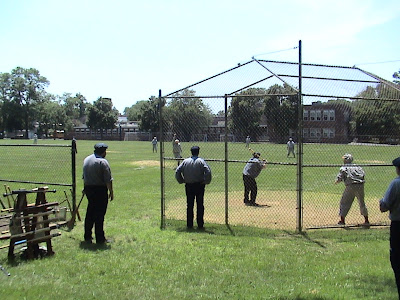When we were organizing the New Jersey committee on the Civil War Sesquicentennial a few years ago, I exchanged some e-mails with someone in New York who had undertaken a similar task in the Empire state. I remember sympathizing with him about the difficulty of forming a state wide organization given the size of New York state.
Here in New Jersey, of course, we tend to think of our state as being relatively small and it's certainly true that one can go make a day trip to almost anywhere in the state (barring traffic). This past Sunday, however, I was reminded that New Jersey is not quite as small as we think or at least as I think of it. The Neshanock traveled to Bridgeton, New Jersey to take on the Athletic Base Ball Club of Philadelphia and as a matter of course, I printed out Internet directions. At the time, the only thing I paid attention to was the exit on the Turnpike (3) since any place in south Jersey has to be close to the Turnpike.
As a result I was more than a little surprised to find out that I had almost an hour more to drive after leaving the Turnpike. I was operating under the misconception that an hour's drive from the Turnpike would have ended either in the Atlantic or the Delaware River!
As I drove through Bridgeton on my way to the site of the match at Alden Field, I found myself wondering how base ball (the New York game) found its way to this south Jersey community. As noted previously I'm researching how base ball developed throughout all of New Jersey so it's a subject that comes to mind on a regular basis. Since base ball tended to spread from urban to rural areas, most likely the game somehow gradually moved from Philadelphia throughout south Jersey. There is a complicating factor, however, Philadelphia was a hot bed for town ball so the transition to base ball was slower than in some areas. For example, the Camden, New Jersey club was still playing town ball as late as 1863.
I'm still in the early stages of researching the spread of base ball in northern New Jersey so it will be a while before I do any detailed research on Bridgeton and the surrounding communities, but the pattern so far in northern New Jersey is interesting. Not surprisingly base ball first took hold in Hudson and Essex Counties, the two counties closest not only to New York and Brooklyn, but also to base ball's incubator at Elysian Fields in Hoboken.
After that, however, the game doesn't seem to have moved very far north or west before 1860, but did seem to move to the south. Base ball clubs were formed and playing in Elizabeth, New Brunswick and even Trenton prior to the Civil War. In Paterson, however, which is closer to Newark and Jersey City there doesn't appear to have been a base ball club even in 1860. That's a little surprising to me since people from Paterson were more likely to have visited Elysian Fields and/or to read Newark, Jersey City and New York newspapers. Next I will look at Bergen and Sussex Counties - west and north of Paterson and I'll be very surprised if I find base ball clubs prior to the Civil War. Of course you never know, after all I did think Bridgeton couldn't be much more than a two hour drive from Verona.































